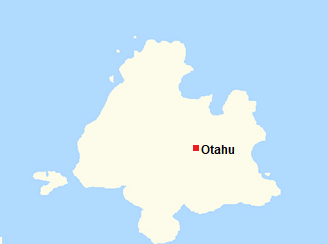Ohawe Territory: Difference between revisions
(Created page with "{{Infobox settlement |native_name = |conventional_long_name = Ohawe Territory |common_name = Ohawe |image_flag = Ohawef...") |
No edit summary |
||
| Line 32: | Line 32: | ||
}} | }} | ||
'''Ohawe''' is a [[Territories of Meridon|territory]] of [[Meridon]], comprising of Ohawe Island and a few surrounding islands. It is bordered to the north and west by[[Alexandria Territory]], to the east by [[Redbird Territory|Redbird]] and [[Smith Island Territory|Smith Island]] territories, and to the south by [[Mahine Territory]]. Redbird's capital and largest city is is [[Otahu]] | '''Ohawe''' is a [[Territories of Meridon|territory]] of [[Meridon]], comprising of Ohawe Island and a few surrounding islands. It is bordered to the north and west by [[Alexandria Territory]], to the east by [[Redbird Territory|Redbird]] and [[Smith Island Territory|Smith Island]] territories, and to the south by [[Mahine Territory]]. Redbird's capital and largest city is is [[Otahu]]. | ||
Ohawe was the home of the indigenous [[Natui]], a relatively advanced Tangaran subculture that were able to create relatively large stone structures, and practiced agriculture as a primary method of subsistence in contrast to other Tangaran tribes who often fished and hunted for a majority of their meals. Although they and a large number of other Tangaran tribes were destroyed in the [[Second Colonial War|Second]] and [[Third Colonial War]], native groups still inhabit the island. | |||
Ohawe is primarily agricultural in its output and produces large amounts of grain, rice, livestock, dairy, and other foodstuffs. Its output of foodstuffs is second to only [[Alexandria Territory|Alexandria]]. Tourism has grown as a significant subsector on the island's southeastern shore in recent years. | |||
==History== | ==History== | ||
Revision as of 14:45, 24 December 2022
Ohawe Territory | |
|---|---|
 Ohawe Territory | |
| Country | Meridon |
| Capital | Otahu |
| Largest city | Otahu |
| Territory | July 3, 1640 |
| Government | |
| • Governor | Chelsea Gibbons (TBD) |
| Population | |
| • Total | TBD |
Ohawe is a territory of Meridon, comprising of Ohawe Island and a few surrounding islands. It is bordered to the north and west by Alexandria Territory, to the east by Redbird and Smith Island territories, and to the south by Mahine Territory. Redbird's capital and largest city is is Otahu.
Ohawe was the home of the indigenous Natui, a relatively advanced Tangaran subculture that were able to create relatively large stone structures, and practiced agriculture as a primary method of subsistence in contrast to other Tangaran tribes who often fished and hunted for a majority of their meals. Although they and a large number of other Tangaran tribes were destroyed in the Second and Third Colonial War, native groups still inhabit the island.
Ohawe is primarily agricultural in its output and produces large amounts of grain, rice, livestock, dairy, and other foodstuffs. Its output of foodstuffs is second to only Alexandria. Tourism has grown as a significant subsector on the island's southeastern shore in recent years.
